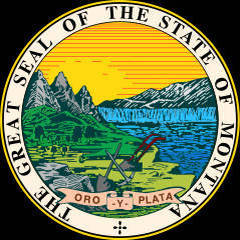
The present City Hall building was originally the
Farmers' State Bank, but had become the
Farmers' National Bank by the time it was purchased by the city for $5,000 in 1930. A relatively small buff brick building, it betrays its banking heritage with a pair of round Doric columns flanking the central entrance and supporting a small portico with extended eaves and a pediment rising to an extended flat top.
At an elevation of 4,196 ft (1,279 m), the City of Harlowton covers an area of 0.63 sq mi (1.62 km
2)
Reaching a peak population of 1,856 in 1920, Harlowton's population has slowly dropped ever since, falling under 1,000 in 2010 and continuing to fall today. This is explained by Harlowton's location in predominantly farming country, an area which began to suffer drought conditions in the 1920s, a decade before the midwest began to experience similar conditions. As a result, banks, including Harlowton's
Farmers' State Bank, and businesses began to fail well before the great stock market crash of 1929 and the beginning of the
Great Depression of the
Dirty Thirties.
Following is the American Guide Series entry for Harlowton in the book
Montana, A State Guide Book.
HARLOWTON
187.3 m. (4,167 alt, 1,473 PP-) seat of Wheatland County, is hidden by river bluffs until the road makes a turn and a descent about a mile from town. At the top of the hill is (L) the GRAVES HOTEL [burned in 2023] built in 1909 of stone quarried from the nearby rim rocks. The town's presence is first revealed by the concrete cylinders (R) of a flour mill. The road turns R. into the main street at the base of the hill. Local stone has been used in a number of buildings here. The town overlooks the Musselshell River and is protected to some extent from the almost continual northerly winds by the river bluffs. Many houses on the west side are perched on the very edge of the river-bank.
Harlowton was named for Richard Harlow, who built the "Jawbone Line" (see TRANSPORTATION). It is a division point on the C. M. St. P. & P. R. R., whose electrified section begins here, and whose shops and yards provide much local employment. The flour mill, outstanding for this region, has 22 storage tanks with a capacity of 25,000 bushels each, and the daily output is 950 barrels of flour and large quantities of poultry and stock feeds. The town is the trading center for a steadily productive sheep and cattle region.
From Montana, A State Guide BookPages 329, 330